

A propos de l’ISP - International School of Paris. Enseignement L'École Internationale de Paris est le seul établissement scolaire en France à offrir les trois programmes du Baccalauréat International (IB) : de la maternelle au lycée.

Nous dispensons une éducation internationale exigeante, culturellement riche, à l’écoute des dernières innovations, et intégrant pleinement les défis environnementaux et sociétaux de notre époque. Emplacement L’ISP est située au cœur de Paris, dans le 16ème arrondissement, à quelques enjambées de la Tour Eiffel. Elle offre à ses élèves deux, bientôt trois campus à la pointe de la modernité, tout en s’appuyant sur l’extraordinaire richesse culturelle et historique de Paris. Histoire L’ISP est une association de loi 1901, école privée hors contrat, avec plus de 50 ans d’expérience dans l’enseignement international. Mix It Up.
Classroom Resources. Diverse Teaching Strategies for Diverse Learners. Global Family Research Project. We are pleased to announce that all of the materials produced by Harvard Family Research Project (1983-2016) are now available in the archive section of our Global Family Research Project site.
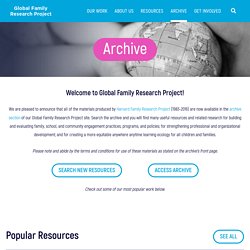
Search the archive and you will find many useful resources and related research for building and evaluating family, school, and community engagement practices, programs, and policies; for strengthening professional and organizational development; and for creating a more equitable anywhere anytime learning ecology for all children and families. Please note and abide by the terms and conditions for use of these materials as stated on the archive's front page.
Search New Resources Access Archive Check out some of our most popular work below. Equity Literacy Institute. Multicultural Pavilion Teachers Corner - Equity and Social Justice Education Resources. EdChange - Advocating Equity in Schools and Society. Critical Practices for Anti-bias Education: Family and Community Engagement. Classroom Resources. Diverse Teaching Strategies for Diverse Learners. Pratt-Johnson - Communicating Cross-Culturally: What Teachers Should Know. The Internet TESLJournal Yvonne Pratt-Johnsonprattjoy [at] stjohns.eduSt.
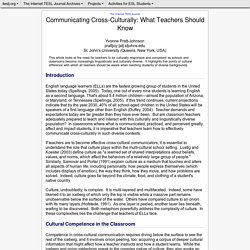
John's University (Queens, New York, USA) This article looks at the need for teachers to be culturally responsive and competent as schools and classrooms become increasingly linguistically and culturally diverse. It highlights five points of cultural difference with which all teachers should be aware when teaching students of diverse backgrounds. Introduction English language learners (ELLs) are the fastest growing group of students in the United States today (Spellings, 2005).
If teachers are to become effective cross-cultural communicators, it is essential to understand the role that culture plays within the multi-cultural school setting. Cultural Competence in the Classroom Acquiring cultural competence is a gradual process. 1. How do cultures come to acquire information? On the other hand, other cultures acquire information through "non-academic" sources--for example, through elders, nature, spirits, or symbols.
Global Family Research Project. Hawaiian language immersion program. Ka Papahana Kaiapuni (KPK) The Hawaiʻi State Department of Education (HIDOE) contributes to Hawaiian language revitalization by providing for K-12 Hawaiian language education.
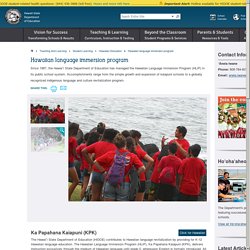
The Hawaiian Language Immersion Program (HLIP), Ka Papahana Kaiapuni (KPK), delivers instruction exclusively through the medium of Hawaiian language until grade 5, whereupon English is formally introduced. All families residing in Hawaiʻi have the option to enroll their children in a Hawaiian language immersion program. Within the organizational structure of the Department, KPK is supported by the Office of Hawaiian Education (OHE) and other state offices as well its complex areas. HIDOE also engages with the community, via the ʻAha Kauleo (‘AKL), to collect stakeholder input on Kaiapuni implementation. KPK standards Nā Ana A‘o Background Ka Papahana Kaiapuni goals focus on the development of a Kaiapuni lens connecting future generations with Hawaiian ways of knowing and being.
Preparing for Cultural Diversity: Resources for Teachers. How can teachers effectively engage students from diverse backgrounds? It's a question many teachers face, and of course, there isn't one prescribed strategy that works. Luckily, there are many useful resources to help new and veteran educators explore the subject. 20140817113327 621624 activity294. ECP 08 13 10. Diversity, Equity And Justice. Differentiated Instruction Ignites Elementary School Learning. General Format. Note: This page reflects the latest version of the APA Publication Manual (i.e., APA 7), which released in October 2019.
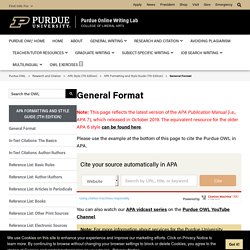
The equivalent resource for the older APA 6 style can be found here. Please use the example at the bottom of this page to cite the Purdue OWL in APA. To see a side-by-side comparison of the three most widely used citation styles, including a chart of all APA citation guidelines, see the Citation Style Chart.
You can also watch our APA vidcast series on the Purdue OWL YouTube Channel. Downloadable Data Sets. How to Create Your Own Infographic. The 9 Types of Infographics [TIPS AND EXAMPLES] Global Industry Market Sizing - NationMaster. Global Education Monitoring Report. Hawaii’s ELL students show progress on Nation’s Report Card. The results released today by the National Assessment of Educational Progress (NAEP) show double-digit gains for Hawaii’s fourth grade English Language Learners (ELL).
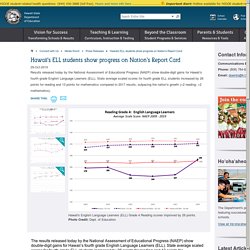
State average scaled scores for fourth grade ELL students increased by 26 points for reading and 13 points for mathematics compared to 2017 results, outpacing the nation’s growth (+2 reading; +2 mathematics). Eighth grade ELL students also outperformed their peers nationally with an increase of five points in reading and seven points in mathematics. “As we continue to review the overall results, we are especially encouraged by the progress shown by our ELL students and having discussions on what strategies have contributed to these encouraging outcomes,” said Assistant Superintendent Heidi Armstrong, Office of Student Support Services.
Hawaii’s overall results, compared to 2009 scores, show a steady increase in all categories bucking the national trend of decreases in all categories over ten years. Superintendent Dr. School Data and Reports. Untitled. A Native Hawaiian Focus on the Hawaii Public School System. The Condition of Education. 20140116015601 760829 activity291. Census.gov. Global Education Monitoring Report.